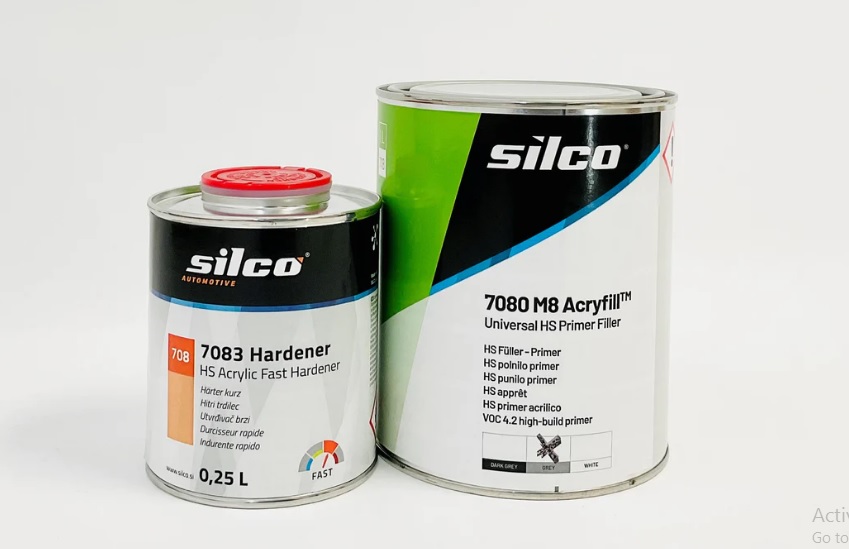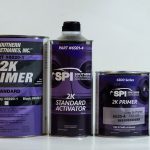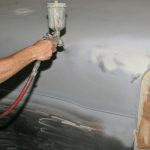The world of automotive DIY projects often revolves around the pivotal question: “Can primer filler go on bare metal?” This query isn’t just a mere technicality; it represents a crossroads where enthusiasts and professionals alike pause to ensure the longevity and quality of their paintwork. In this extended guide, we’ll embark on a journey to unravel the nuances, providing you with a comprehensive understanding of applying primer filler to bare metal surfaces.
Getting Acquainted with Primer Filler
1. The Magic of Primer Filler
Primer filler, a versatile coating, serves as the unsung hero in the realm of surface preparation. Not only does it conceal imperfections, but it also establishes an ideal canvas for subsequent layers of paint. Before we explore its compatibility with bare metal, let’s delve deeper into its composition and functions.
What’s in Primer Filler?
Primer fillers typically contain a blend of resins, pigments, solvents, and additives. The resins contribute to adhesion, while pigments and additives enhance durability and fill surface imperfections.
The Dual Role of Primer Filler
Aside from providing a smooth surface for paint adhesion, primer fillers boast the unique ability to offer protection against corrosion. This makes them an indispensable ally in the battle against the elements, particularly for bare metal surfaces vulnerable to rust.
Unraveling the Bare Metal Conundrum
2. Challenges of Bare Metal Surfaces
Bare metal, though pristine in its raw form, poses distinctive challenges that necessitate careful consideration. Lack of existing coatings means that these surfaces are more susceptible to corrosion, and without proper preparation, the adhesion of subsequent layers may be compromised.
The Corrosion Conundrum
Bare metal’s Achilles’ heel lies in its vulnerability to corrosion. Primer filler, if applied correctly, can act as a formidable shield, preventing rust from wreaking havoc on your project.
3. Ensuring Chemical Compatibility
The marriage between primer filler and bare metal hinges on chemical compatibility. Investing in a primer specifically designed for metal surfaces ensures optimal adhesion and longevity.
Reading the Label
When selecting a primer filler, pay close attention to the label. Look for formulations explicitly stating compatibility with bare metal. This small but crucial detail can make a significant difference in the success of your project.
4. The Dance of Surface Preparation
Proper surface preparation is the backbone of a successful primer filler application. Skipping or skimping on this step is akin to building a house on a shaky foundation—disaster is imminent. Let’s break down the essential steps.
Thorough Cleaning
Before anything else, ensure the bare metal is squeaky clean. Grease, dirt, and contaminants can be insidious adversaries, hindering the primer filler’s ability to adhere.
Abrasions for Adhesion
A light abrasion of the metal surface is paramount. This not only removes any remaining impurities but also creates a slightly roughened texture, offering the primer filler a better surface to grip onto. (See Also: VHT Flameproof vs. Ceramic Coating: Unraveling the Best Heat Protection)
Mastering the Art of Primer Filler Application
5. The First Coat: Setting the Stage
The initial coat of primer filler is more than just a preparatory step; it’s a foundation upon which the entire project rests. Here’s where you lay the groundwork for a flawless finish.
Even Application
Begin with a thin, even coat. This not only conserves your primer but also ensures a consistent layer that promotes strong adhesion.
Addressing Rust-Prone Areas
Pay special attention to areas prone to rust, such as edges and joints. The primer filler acts as a protective barrier, thwarting the advances of corrosion.
6. Between Coats: The Sanding Symphony
Sanding between coats is the secret sauce for a smooth and professional finish. This isn’t just about vanity; it’s about functionality and durability.
Smoothing the Surface
Each coat should be sanded lightly before the application of the next. This smoothens the surface, eliminating imperfections and providing an ideal canvas for subsequent layers.
Building Layers: Thin is In
While it might be tempting to go for a thick application, resist the urge. Multiple thin layers offer better control and minimize the risk of uneven surfaces.
Navigating Common Pitfalls
7. Pitfalls to Dodge Like a Pro
No journey is without its obstacles, and applying primer filler is no exception. Let’s explore common pitfalls and how to navigate them.
Surface Cleaning Oversight
One of the cardinal sins is neglecting to clean the bare metal adequately. A seemingly innocuous speck of dust can become a glaring imperfection in your final paint job.
The Drying Dilemma
Impatience can be your worst enemy. Rushing the drying process between coats jeopardizes the integrity of the primer filler, leading to potential imperfections.
Troubleshooting for a Seamless Finish
8. Addressing Adhesion Woes
Encountering adhesion issues can be disheartening, but fear not—there’s often a solution. (See Also: Raptor Liner vs. Rhino Liner: Choosing the Best Bedliner for Your Vehicle)
Reassessing Surface Preparation
If adhesion problems persist, revisit the surface preparation steps. Inadequate cleaning or improper abrasion might be the culprits. Rectify these issues before proceeding.
9. Tackling Uneven Texture
Uneven texture can be a thorn in your side. The good news is that it’s often a fixable issue.
Sanding and Reapplication
For uneven texture, consider sanding the affected area and reapplying primer filler. This corrective action can salvage the situation and lead to a smoother surface.
Expert Tips for Mastering Primer Filler on Bare Metal
Embarking on the journey of applying primer filler to bare metal requires more than just technical know-how—it demands a keen understanding of the nuances involved. To ensure your project not only meets but exceeds expectations, consider these expert tips that elevate your primer filler application to an art form.
1. Begin with Precision: The Foundation of Success
Before the first drop of primer filler touches the bare metal, precision is your greatest ally. Ensure every surface is meticulously cleaned, and abrasion is done with finesse. A well-prepared canvas sets the stage for a flawless masterpiece.
2. Thin Coats, Strong Bonds: The Art of Layering
Resist the urge to apply thick coats. Instead, opt for multiple thin layers. This technique not only grants you better control over the application but also fosters stronger bonds between the primer filler and bare metal, ensuring durability and longevity.
3. Patience in Drying: The Virtue of Perfection
In the world of primer filler application, patience truly is a virtue. Rushing the drying process between coats jeopardizes the integrity of the primer filler and compromises the final finish. Allow each layer the time it needs to cure properly.
4. Sanding: The Silent Symphony of Smoothness
Sanding between coats isn’t just a formality; it’s the secret to achieving a smooth and professional finish. Embrace the sanding process, and your primer filler will reward you with a surface free of imperfections, ready for the next layer.
5. Spot-Check Rust-Prone Areas: A Stitch in Time
Don’t overlook the areas prone to rust. These are the battlegrounds where corrosion seeks to make its mark. By giving special attention to these spots during application, you create a robust defense against the persistent threat of rust.
6. Quality Primer Matters: Choosing Wisely
Investing in a high-quality primer filler designed explicitly for bare metal is non-negotiable. Read product labels, seek recommendations, and choose a primer that aligns with the unique demands of bare metal surfaces. (See Also: Can You Paint Over Epoxy Primer? A Step-by-Step Guide)
7. Precision in Troubleshooting: Addressing Adhesion
If adhesion issues arise, resist the temptation to take shortcuts. Instead, meticulously reassess the surface preparation steps. Rectifying any oversights at this stage often resolves adhesion woes, ensuring a solid foundation for subsequent coats.
8. Embrace Sanding for Texture Woes: A Gentle Remedy
Uneven texture can be a stumbling block, but it’s not an insurmountable one. Embrace the gentle remedy of sanding and reapplication. This allows you to correct imperfections, leading to a smoother and more refined surface.
9. Weather Considerations: Mother Nature’s Role
Take note of environmental conditions during application. Extreme temperatures or humidity can impact drying times and overall performance. Plan your primer filler application on a day when Mother Nature is cooperative for optimal results.
10. Quality Tools Matter: Invest in Excellence
Your tools are an extension of your craftsmanship. Invest in quality brushes, rollers, or spray equipment to ensure an even and controlled application of primer filler. The right tools not only make the job easier but contribute to the overall quality of the finish.
Incorporating these expert tips into your primer filler application process transforms it from a routine task into a craftsmanship pursuit. With precision, patience, and a commitment to excellence, you’ll not only answer the question of whether primer filler can go on bare metal but also create a masterpiece that stands the test of time.
Conclusion: A Canvas Transformed
In the grand tapestry of automotive restoration and DIY painting, the question of whether primer filler can go on bare metal finds its answer in meticulous preparation and step-by-step application. Armed with the insights shared in this extensive guide, you’re equipped to transform bare metal surfaces into a canvas awaiting the brushstrokes of vibrant and long-lasting paint.
So, embrace the challenge, take your time, and revel in the journey of turning raw metal into a work of art—one layer of primer filler at a time. Happy painting!



